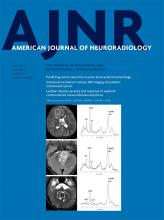Index by author
Aghayev, E.
- EDITOR'S CHOICESpineOpen AccessLumbar Spinal Stenosis Severity by CT or MRI Does Not Predict Response to Epidural Corticosteroid versus Lidocaine InjectionsF.A. Perez, S. Quinet, J.G. Jarvik, Q.T. Nguyen, E. Aghayev, D. Jitjai, W.D. Hwang, E.R. Jarvik, S.S. Nedeljkovic, A.L. Avins, J.M. Schwalb, F.E. Diehn, C.J. Standaert, D.R. Nerenz, T. Annaswamy, Z. Bauer, D. Haynor, P.J. Heagerty and J.L. FriedlyAmerican Journal of Neuroradiology May 2019, 40 (5) 908-915; DOI: https://doi.org/10.3174/ajnr.A6050
In this secondary analysis of the CT and MR imaging studies of the prospective, double-blind Lumbar Epidural Steroid Injections for Spinal Stenosis (LESS) trial participants, the authors found no differences in baseline imaging characteristics between those receiving epidural corticosteroid and lidocaine and those receiving lidocaine alone injections. No imaging measures of spinal stenosis were associated with a differential response to corticosteroids, indicating that imaging parameters of spinal stenosis did not predict a response to epidural corticosteroids.
Ahmed, R.
- NeurointerventionYou have accessTreatment of Wide-Neck Intracranial Aneurysms with the Woven EndoBridge Device Associated with Stenting: A Single-Center ExperienceF. Cagnazzo, R. Ahmed, C. Dargazanli, P.-H. Lefevre, G. Gascou, I. Derraz, S.A. Kalmanovich, C. Riquelme, A. Bonafe and V. CostalatAmerican Journal of Neuroradiology May 2019, 40 (5) 820-826; DOI: https://doi.org/10.3174/ajnr.A6032
Ahn, K.J.
- NeurointerventionYou have accessImage Quality of Low-Dose Cerebral Angiography and Effectiveness of Clinical Implementation on Diagnostic and Neurointerventional Procedures for Intracranial AneurysmsJ. Choi, B. Kim, Y. Choi, N.Y. Shin, J. Jang, H.S. Choi, S.L. Jung and K.J. AhnAmerican Journal of Neuroradiology May 2019, 40 (5) 827-833; DOI: https://doi.org/10.3174/ajnr.A6029
Amans, M.R.
- Head & NeckOpen AccessReduced Jet Velocity in Venous Flow after CSF Drainage: Assessing Hemodynamic Causes of Pulsatile TinnitusH. Haraldsson, J.R. Leach, E.I. Kao, A.G. Wright, S.G. Ammanuel, R.S. Khangura, M.K. Ballweber, C.T. Chin, V.N. Shah, K. Meisel, D.A. Saloner and M.R. AmansAmerican Journal of Neuroradiology May 2019, 40 (5) 849-854; DOI: https://doi.org/10.3174/ajnr.A6043
Ammanuel, S.G.
- Head & NeckOpen AccessReduced Jet Velocity in Venous Flow after CSF Drainage: Assessing Hemodynamic Causes of Pulsatile TinnitusH. Haraldsson, J.R. Leach, E.I. Kao, A.G. Wright, S.G. Ammanuel, R.S. Khangura, M.K. Ballweber, C.T. Chin, V.N. Shah, K. Meisel, D.A. Saloner and M.R. AmansAmerican Journal of Neuroradiology May 2019, 40 (5) 849-854; DOI: https://doi.org/10.3174/ajnr.A6043
Annaswamy, T.
- EDITOR'S CHOICESpineOpen AccessLumbar Spinal Stenosis Severity by CT or MRI Does Not Predict Response to Epidural Corticosteroid versus Lidocaine InjectionsF.A. Perez, S. Quinet, J.G. Jarvik, Q.T. Nguyen, E. Aghayev, D. Jitjai, W.D. Hwang, E.R. Jarvik, S.S. Nedeljkovic, A.L. Avins, J.M. Schwalb, F.E. Diehn, C.J. Standaert, D.R. Nerenz, T. Annaswamy, Z. Bauer, D. Haynor, P.J. Heagerty and J.L. FriedlyAmerican Journal of Neuroradiology May 2019, 40 (5) 908-915; DOI: https://doi.org/10.3174/ajnr.A6050
In this secondary analysis of the CT and MR imaging studies of the prospective, double-blind Lumbar Epidural Steroid Injections for Spinal Stenosis (LESS) trial participants, the authors found no differences in baseline imaging characteristics between those receiving epidural corticosteroid and lidocaine and those receiving lidocaine alone injections. No imaging measures of spinal stenosis were associated with a differential response to corticosteroids, indicating that imaging parameters of spinal stenosis did not predict a response to epidural corticosteroids.
Anxionnat, R.
- Adult BrainYou have accessSusceptibility-Weighted Angiography for the Follow-Up of Brain Arteriovenous Malformations Treated with Stereotactic RadiosurgeryS. Finitsis, R. Anxionnat, B. Gory, S. Planel, L. Liao and S. BracardAmerican Journal of Neuroradiology May 2019, 40 (5) 792-797; DOI: https://doi.org/10.3174/ajnr.A6053
Aoki, S.
- EDITOR'S CHOICENeurointerventionYou have accessUsefulness of Silent MR Angiography for Intracranial Aneurysms Treated with a Flow-Diverter DeviceH. Oishi, T. Fujii, M. Suzuki, N. Takano, K. Teranishi, K. Yatomi, T. Kitamura, M. Yamamoto, S. Aoki and H. AraiAmerican Journal of Neuroradiology May 2019, 40 (5) 808-814; DOI: https://doi.org/10.3174/ajnr.A6047
Silent MRA is a procedure using an ultrashort TE and arterial spin-labeling techniques, which efficiently visualizes the status after the treatment of intracranial aneurysms. In Silent MRA, the 3D image is reconstructed by subtracting the control image from the image obtained by the labeling pulse. Seventy-eight large, unruptured internal carotid aneurysms in 78 patients were the subjects of this study. After 6 months of treatment, they underwent follow-up digital subtraction angiography, Silent MRA, and TOF-MRA, performed simultaneously. The authors found Silent MRA is superior for visualizing blood flow images inside flow-diverter devices compared with TOF-MRA. Furthermore, Silent MRA enables the assessment of aneurysmal embolization status. Silent MRA is useful for assessing the status of large and giant unruptured internal carotid aneurysms after flow-diverter placement.
Arai, H.
- EDITOR'S CHOICENeurointerventionYou have accessUsefulness of Silent MR Angiography for Intracranial Aneurysms Treated with a Flow-Diverter DeviceH. Oishi, T. Fujii, M. Suzuki, N. Takano, K. Teranishi, K. Yatomi, T. Kitamura, M. Yamamoto, S. Aoki and H. AraiAmerican Journal of Neuroradiology May 2019, 40 (5) 808-814; DOI: https://doi.org/10.3174/ajnr.A6047
Silent MRA is a procedure using an ultrashort TE and arterial spin-labeling techniques, which efficiently visualizes the status after the treatment of intracranial aneurysms. In Silent MRA, the 3D image is reconstructed by subtracting the control image from the image obtained by the labeling pulse. Seventy-eight large, unruptured internal carotid aneurysms in 78 patients were the subjects of this study. After 6 months of treatment, they underwent follow-up digital subtraction angiography, Silent MRA, and TOF-MRA, performed simultaneously. The authors found Silent MRA is superior for visualizing blood flow images inside flow-diverter devices compared with TOF-MRA. Furthermore, Silent MRA enables the assessment of aneurysmal embolization status. Silent MRA is useful for assessing the status of large and giant unruptured internal carotid aneurysms after flow-diverter placement.
Augustyn, R.A.
- PediatricsYou have accessComparison of Iterative Model Reconstruction versus Filtered Back-Projection in Pediatric Emergency Head CT: Dose, Image Quality, and Image-Reconstruction TimesR.N. Southard, D.M.E. Bardo, M.H. Temkit, M.A. Thorkelson, R.A. Augustyn and C.A. MartinotAmerican Journal of Neuroradiology May 2019, 40 (5) 866-871; DOI: https://doi.org/10.3174/ajnr.A6034








